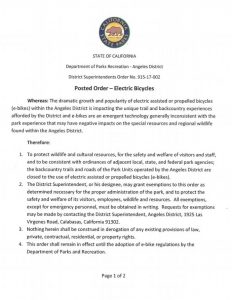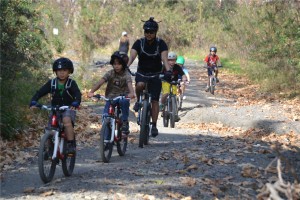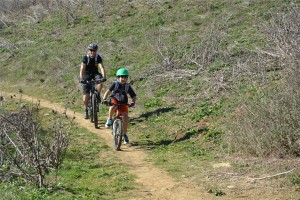 As we reported last year, a new Topanga General Plan is being developed by California State Parks. The plan will guide Topanga State Park’s future, ensuring that management practices are in line with the mission and objectives of the Park.
As we reported last year, a new Topanga General Plan is being developed by California State Parks. The plan will guide Topanga State Park’s future, ensuring that management practices are in line with the mission and objectives of the Park.
The general plan does not govern trail use designations, and instead defers to the Santa Monica Mountains Trails Master Plan, which is still in development.
The current draft of the plan was released in December. The public comment period ends today, January 23, 2012. Below are the comments that CORBA is submitting. Members of the public are also welcome to comment on the plan, which can be found at http://parks.ca.gov/?page_id=25956.
February 23, 2012
Luke Serna, Environmental Coordinator
Topanga General Plan Team
California State Parks
Southern Service Center
8885 Rio San Diego Drive, Suite 270
San Diego, CA 92108
Re.: Topanga State Park General Plan
Dear Mr. Serna,
Thank you for the opportunity to comment on the Topanga State Park General Plan. We have been involved in the process from the first public hearings, and are happy to see the plan approach its final iterations. We congratulate you and the staff for moving the plan forward. However, as CORBA represents off-road cyclists, there are a few items and omissions in the current draft about which we have some concerns.
1. We read on page 49 “Eight additional focus group meetings were held to better understand a few site specific issues.” Then number 5 on page 50 mentions a focus group on user conflicts. CORBA as an organization representing off-road cyclists was not made aware of, and did not attend any such focus group. Nor did any of our members or anyone we can find in the bicycling community. There aren’t any details of who called the group or how that group’s findings may have affected the final plan. Without cyclists present, we are concerned that an unbalanced representation of user conflicts may have been made. Exclusion of one user group from such a focus group cannot possibly foster multi-use principles, just as excluding a user group from a trail furthers and deepens user conflicts when they do occur. Please document and clarify the process used to form this focus group and its findings as they pertain to the general plan. This would perhaps be suitable for inclusion as an appendix.
2. On page 65, it states “1. a. This management plan will address the ability of bikes, horses and other pack animals, and fire, construction and Park vehicles to carry and spread exotic plant seed throughout the Park.” There is no mention of hiking boots, running shoes, shoe tread, socks or clothes as a vector for the spread of exotic seed. This should also be of concern and should be addressed, especially since hikers are much more likely than cyclists to go off-trail where they can be exposed to more seed than would otherwise be encountered by those staying on the trail. We feel this is an omission.
3. Page 53 states that “trail-use designations are not part of this plan…. However, trail corridors, as well as trail goals and guidelines, will be established as a part of this process.” While these “trail corridors” appear in the legend of the map on page 105, the scale of the map and the visual indicators used in the legend do not allow for the easy identification of or distinction between “corridors” and existing trails. A verbal description of each trail corridor proposed and/or a larger scale map would do much to alleviate and prevent any confusion. We feel we cannot adequately comment on the proposed trail corridors without fully understanding them.
4. In Table 3, “Planning Matrix” on page 113, the Lagoon, Watershed Zone and Lower Topanga zones are listed as being restricted to “hiking on designated trails only.” To list an entire zone off-limits to other user groups will hamper the efforts to complete the Coastal Slope trail as it is envisioned–a multi-use long distance trail–that will pass through that zone. The Coastal Slope trail itself appears on the Lower Topanga/Lagoon Preferred Plan “Range of possible features” on page 115. Making trail use decisions on a trail-by-trail basis, rather than a blanket closure of an entire area, will allow for better management of users in the area, and reduce impediments to the planned Coastal Slope Trail.
5. According to the plan Musch Campground is open to bicycles. However, the Musch Trail is currently closed to bicycle use. A formal change-in-use request has been submitted to convert that trail to multi-use including bicycles. How is Musch Campground currently accessed by bicycles?
Off-road cycling is a healthy outdoor recreational activity that entices people away from their couches and computers and into our treasured open spaces. Cyclists comprise a large portion of State Park visitors, yet only fire roads and Rogers Road are currently open to bikes in Topanga SP, concentrating bicycles on fewer trails, and placing them on wide fire roads that encourage high rates of downhill speed. This contributes to user conflicts and creates further divisiveness between user groups. We would like to see the General Plan recognize cycling as a legitimate, welcomed and, when managed appropriately, sustainable activity in Topanga State Park.
CORBA has a long history with State Parks in the Santa Monica Mountains. Our trail crew volunteers have worked on Rogers Road and many other trails in neighboring State Park units for many years. We note in the plan that there is a recommendation to continue to work with volunteer and non-profit groups. We work side-by-side with other user groups at State Trails Day and other events. CORBA works constantly to educate, inform and encourage off-road cyclists to practice good trail etiquette, and the vast majority do. We look forward to continuing and furthering our relationship with Topanga State Park and other SP units in the Santa Monica Mountains.
Thank you,
Concerned Off-Road Bicyclists Association
 The California Department of Parks and Recreation current policy regarding e-MTBs leaves the decision at the District level, until such time as a formal state-wide policy is adopted. The order goes into effect on October 1st, 2017.
The California Department of Parks and Recreation current policy regarding e-MTBs leaves the decision at the District level, until such time as a formal state-wide policy is adopted. The order goes into effect on October 1st, 2017.








State Parks Programatic EIR Public Hearing
Wednesday, November 10th, 2010This Saturday, November 13, California State Parks will be hosting the final public hearing on their Draft Programatic EIR.
Bicycle access to trails in the Santa Monica Mountains and many other areas will be directly affected by the final version of this document, so it is important to ensure that mountain bikers are fully engaged in this process. CORBA and IMBA representatives will be attending, and we urge everyone who would like to see more trails opened for bicycles in State Parks to attend and make comments.
What is a Programatic EIR? This is an effort to streamline the process of converting trails from one designation, such as hiker-only, to another designation, such as multi-use. This is good for mountain biking. According to IMBA:
California State Park’s Director Ruth Coleman has embraced a statewide Programatic Environmental Impact Report (PEIR) that will improve the process to convert trails to shared-use status. “This will lay the groundwork for the efficient conversion of trails that IMBA California and clubs have been requesting for some time,” says IMBA California’s Tom Ward. This bodes well for efforts to open Bill’s Trail in Marin, as well as numerous trails in Santa Cruz and Humboldt counties, Mt Diablo State Park, Folsom State Recreation Area, Donor Lake State Park, various Sonoma County parks and miles of trails in the Los Angeles basin. According to Ward, park managers have often shown support for improved mountain bike access — but each time they attempt implementation they are threatened with lawsuits from opposing forces. “The intent of PEIR is to curtail the legal challenges to each trail conversion project,” says Ward. He adds, “This is a major milestone for IMBA’s efforts to increase mountain bike access in state parks.”
The meeting will take place from:
1:00 to 4:00 p.m. Saturday, November 13
Lake Activities Building,Lake Perris State Recreation Area,
17801 Lake Perris Drive,
Perris, CA 92571 [map].
The Notice of Preparation for the draft PEIR can be found at http://www.parks.ca.gov/?page_id=980. Public comments are being accepted through November 30. Comments on the PEIR may be submitted in person at the workshops, or by either mail to:
Environmental Coordinator – Trails PEIR
1 Capitol Mall, Suite 410
Sacramento, CA 95814
Or by email to: ceqansc@parks.ca.gov
(Note: In the Subject Line, write: ‘Trails PEIR’)
Comments can also be submitted by Fax to: (916) 445-8883; Please address faxes to: Environmental Coordinator – Trails PEIR
We’ll have more details and a more thorough report after Saturday’s presentation and hearing.
Tags:Advocacy, Public Comments, public hearings, Santa Monica Mountains, State Parks, Topanga
Posted in Advocacy, California, Santa Monica Mountains, Trail Access | Comments Closed